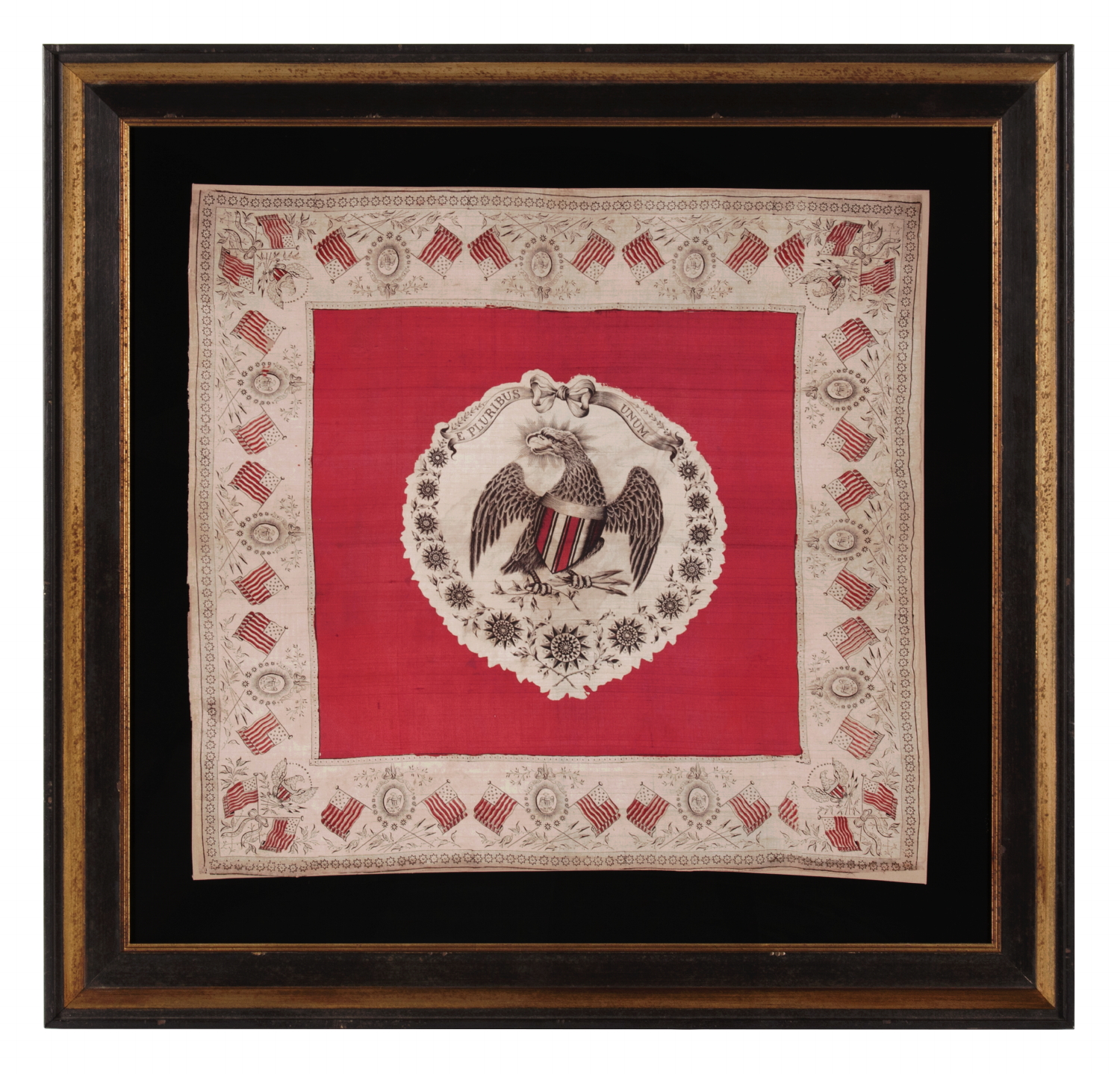
| |
RARE, SILK, PATRIOTIC KERCHIEF WITH A DYNAMIC EAGLE AND 13 MARINER'S COMPASS-TYPE STARS, MADE CA 1840, ONE OF ONLY TWO KNOWN EXAMPLES IN THIS UNDOCUMENTED STYLE |
|
| Available: |
Sold |
| Frame Size (H x L): |
38.75" x 40.5" |
| Flag Size (H x L): |
27.5" x 29.25" |
|
| Description....: |
|
Vibrant color and wonderful graphics adorn this especially rare patriotic kerchief, printed on silk, that presently survives as one of only two known examples. Made sometime between the mid-1830s and the mid-1850's, the textile's splendid imagery includes is centered upon a scarlet red field, in the midst of which is an open medallion containing a fierce American eagle, gripping an olive branch in its proper right talon and arrows in its left. Note how the eagle's head is facing to the right, towards the olive branch. This symbolism could hold a message of peace, though the disposition of the great bird is clearly formidable and the branch bears no fruit. The shield upon the eagle's breast is interesting, consisting of only red and white pales, separated by double-lines, and no stars. The lack of blue probably occurs because the color is absent in the design entirely.
The eagle is surrounded by a crescent-shaped wreath of 13 stars in a spectacular mariner's compass design, intermingled with more olive or laurel leaves (very hard to discern between the two). At the top is a bow with ends that serve as ribbon streamers with the "E Pluribus Unum" slogan (out of many, one).
The wide white border is decorated with smaller versions of the central device that are set within crossed 13 star flags, interspersed with more arrows and laurel or olive branches. Flanking each corner is a different style of eagle, this one appearing with an arch of 13 stars connecting the upward tips of the spread wings, and between the vortex of crossed flags, tied where they intersect with a bow that bears the "E Pluribus Unum" slogan. The bird faces toward the arrows in this instance.
All of the flags have 14 stripes, which is probably an oversight. Note how their blue cantons rest on a red stripe as opposed to a white one. When this condition exists, we say that they canton rests on the “war stripe” or “blood stripe”, and this feature, while rare, has been suggested by some flag enthusiasts to have been included when our nation was at war. Sometimes it is simply an error, but whatever the case may be, collectors like to see it because it it's an interesting myth and unusual to encounter.
The large scale of the textile, the colors and the imagery all point to the Antebellum era, as the nation reluctantly poised for war. The silk is not weighted, which also points toward a pre-Civil War date. The bright, scarlet red would sometimes suggest 1850's or after, because red dyes used in 1840's silk kerchiefs typically achieve a brick red tone over time, whether or not they are exposed to light. There are exceptions to the rule, however, and among them are examples made for the 1840 presidential campaign of William Henry Harrison and the 1844 campaign of Henry Clay. Three versions of a known Harrison style are so similar in their overall design and color scheme that that one may conclude with relative certainty that they were produced by the same maker. Examples of these are documented in “Threads of History”, by Herbert Ridgeway Collins (Smithsonian Press, 1979), as items 122, 123, and 124 on pages 98 and 99. Harrison is generally considered to have been the first man to actively campaign for the presidency and textiles and flags made for his campaign are the first known to exist in any quantity whatsoever. Only two known campaign kerchiefs are currently known that survive from before 1840.
Because there are no designs that look so much like the eagle kerchief in question made after 1840, that year or the immediate vicinity seems the most likely date.
Early kerchiefs that feature simply patriotic imagery--not featuring a specific political candidate or president, are extraordinarily rare. There is one that says "May the Best Man Win" that is political but not party specific. Three of those in that style are known. There is a Civil War version with flags and cannons. Just a tiny handful are known of that type as well. I can recall having seen 2 or 3. Only one other in the style of this eagle variety is known. I have been privileged to own both examples, neither of which has been documented in any text.
The combination of date, rarity, scale, excellent colors and graphics make this a masterpiece of mid-19th century American textiles.
Mounting: This is a pressure mount between 100% cotton twill, black in color, and U.V. protective plexiglass. The black fabric was washed to reduce excess dye. An acid-free agent was added to the wash to further set the dye and the fabric was heat-treated for the same purpose. The mount was then placed in a black-painted, hand-gilded and distressed Italian molding.
Condition: There is some soiling in limited areas. There are minor losses around the perimeter. Fabric of similar coloration was placed behind the textile for masking purposes and to strengthen the color against the dark ground. The colors are remarkably strong and vibrant. The great rarity and early date, well-warrants the minor condition issues. |
|
|
|
| Collector Level: |
Flags for the truest Patriots. My best offerings |
|
| Flag Type: |
|
|
| Star Count: |
|
|
| Earliest Date of Origin: |
1835 |
|
| Latest Date of Origin: |
1855 |
|
| State/Affiliation: |
|
|
| War Association: |
1777-1860 Pre-Civil War |
|
| Price: |
SOLD |
|
| |
Views: 2601 |
|
|
|

